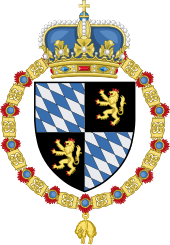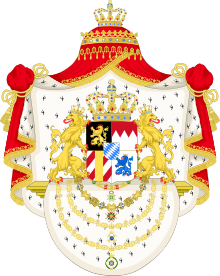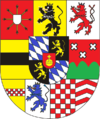Bavarian state coat of arms
The Bavarian state coat of arms in its current form was introduced on June 5, 1950 with the "Law on the coat of arms of the Free State of Bavaria ". The design was created by Eduard Ege in 1945 .
description


Large national coat of arms
“The large Bavarian national coat of arms consists of a quartered shield with a heart shield. The first field shows in black an upright golden, red-armored lion; the second field is divided by red and white (silver) with three points rising from the white; the third field shows a blue, gold-armored panther on a white (silver) background; in the fourth field, three black lions with red armor, arranged one above the other, are depicted on gold. The heart shield is roughened diagonally on the right in white (silver) and blue. The shield is held by two golden lions armed in red . A people's crown rests on the shield ; it consists of a gold hoop adorned with stones and adorned with five ornamental leaves. ”() A depiction of the large national coat of arms without the lions as a shield holder is incorrect, but occurs again and again, for example on a German postage stamp from 1992.
The individual heraldic elements of the "large Bavarian state coat of arms" have historical significance.
The golden lion
The golden lion in the black field was originally the symbol of the Count Palatine near the Rhine. After the Bavarian Duke Ludwig was enfeoffed with the Palatinate County in 1214 , it served for centuries as a common hallmark of the old Bavarian and Palatinate Wittelsbachers . From 1923 the erect, golden and red-armored Palatinate lion stood in the heraldic upper left field for the administrative district of Upper Palatinate , until 1945 also for the Palatinate . Since 1950 it has been in the top left ( heraldic right ) field.
The "Franconian Rake"
The second field shows three white (silver) tips in red. This " Franconian rake " called figure appeared around 1350 as the coat of arms of some places of the bishopric of Würzburg and since 1410 also in the seals of the prince-bishops. Today the Franconian rake stands for the Franconian administrative districts of Upper Franconia , Middle Franconia and Lower Franconia .
The blue panther
The third field shows an upright, blue, gold-armored panther on a silver (white) background. Originally it was featured in the coat of arms of the Count Palatine von Ortenburg , who lived in Lower Bavaria . Later it was taken over by the Wittelsbach family . Today the blue panther represents the old Bavarian administrative districts of Lower Bavaria and Upper Bavaria .
The three black lions
In the fourth field three black, red-armored lions (actually leopards) arranged one above the other are depicted on gold. They are taken from the old coat of arms of the Staufer , the former dukes of Swabia. In the national coat of arms these three lions represent the administrative region of Swabia .
The white and blue heart shield
The white-blue heart shield is roughened diagonally in white (silver) and blue. The order of the awakenings ( diamonds ) results from the fact that the diamond in the upper left ( heraldic right ) corner of the shield is white. It used to be the coat of arms of the Counts of Bogen. After they died out in 1242, the Wittelsbachers retained their fief and took over their coat of arms.
The Counts of Bogen were an important Bavarian noble family 800 years ago. Since the middle of the twelfth century, nobles had a coat of arms that u. a. on the sign (to distinguish between tournaments and fights). Assumptions about the choice of diamond pattern concern the reinforcement of the shields. Iron grids used for reinforcement may have developed into the familiar diamond pattern over time.
The oldest surviving impression from 1247 comes from Ludwig II, Duke of Bavaria . Since then, the Wittelsbachers have adopted it as their family coat of arms. The place in the middle, known as the heart shield, was given to the diamonds in 1835 (under Ludwig I , King of Bavaria ), since then as a symbol for all of Bavaria.
It is not known why the diamonds are white and blue. The original designation was silver-blue, but since in heraldry silver is represented by the color white without changing the meaning, "white-blue" has established itself as the designation of the Bavarian colors. The white and blue diamonds are officially used as the “Small State Coat of Arms”.
The people's crown
The people's crown on the quartered shield with the heart shield in the middle consists of a golden hoop adorned with stones and adorned with five ornamental leaves. The people's crown, which can be found for the first time in the coat of arms from 1923, designates popular sovereignty after the royal crown was no longer used .
Small national coat of arms
"The small Bavarian national coat of arms consists of a shield, roughened diagonally to the right in white (silver) and blue, on which the people's crown rests." ()
Country symbol
Since the national coat of arms may only be used by official bodies, national symbols, also known as coats of arms , were introduced: On the one hand, a shield with a diamond pattern and a gold border, on the other hand (for Franconia) the Franconian rake in a gold-edged shield. The symbols may be used freely as long as no sovereign character is awakened, i.e. no animals carrying shields, a crown or the like may be added.
The list of coats of arms with Bavarian diamonds provides a detailed list .
history
Until the end of the monarchy in Bavaria in 1918, the coat of arms of Bavaria was that of the respective prince . The earliest surviving coats of arms of the Wittelsbachers, the rulers of Bavaria from 1180 to 1918, can be found on seals , which is why the colors have not been passed down. The first verifiable coat of arms in a seal comes from Otto I and is on a document from 1179. It shows an eagle looking to the left . This heraldic animal is also shown on a seal from 1196 by Otto's son Ludwig the Kelheimer , but with a view to the right. On another tab seal of the same from 1220, however, a coat of arms with a jagged bar is shown. The origin of these early coats of arms is not clear.
With the marriage of Ludwig's son Otto II. To Agnes von der Pfalz in May 1222, the Palatinate lion from the coat of arms of the Welfs became part of the Wittelsbach family. It can be seen for the first time on a Bavarian duke seal of Otto II in 1229/30, golden, in a black field and reinforced in red, but not crowned. The first recorded representation of a red crowned lion comes from 1252.
When the Counts of Bogen died out in 1242, their possessions and also the coat of arms with the white and blue alarm clock passed to the Wittelsbach family. The first surviving document of Bavarian dukes that was sealed with this coat of arms dates from December 1, 1247. The sons of Otto II split up the duchy in 1255 : Ludwig the Strict continued to use the diamond shield in the Duchy of Upper Bavaria , and from 1289 he also used Palatinate lions. Heinrich rules the Duchy of Lower Bavaria and also has the diamonds and lions as coats of arms. In a rider's seal from 1259 there is a new image, namely the panther , which came from the coat of arms of the Counts of Ortenburg-Kraiburg , whose possessions the Wittelsbachers had taken over. The dukes of Lower Bavaria kept the lion, the diamond and the panther united in one seal until the death of Johann the child, whose father-in-law Ludwig the Bavarian reunited the two partial duchies of old Bavaria. Thereupon Ludwig the Bavarian adopted the coat of arms with panthers, lions and diamonds and his son Ludwig the Romans also used it.


Due to the house contract of Pavia , two Wittelsbach lines existed from 1329 to 1777: the older Palatinate (Rudolfine) line ruled over the Rhine and Upper Palatinate , the younger old Bavarian (Ludwig) line kept the other areas of the duchy. The latter line used diamonds and lions together or alternately in its coat of arms. In 1320 Ludwig V was enfeoffed with the Margraviate of Brandenburg and, in addition, led to the lozenges Mann and Adler. Brandenburg was lost again in 1373. After the renewed division of the country in 1392, the coat of arms was usually composed of diamonds and lions. Since 1438, when Albrecht the Pious took office , it was a square shield with the lion in the first and fourth and the diamonds in the second and third field. A change only took place when Maximilian I obtained the electoral dignity for the dukes of Bavaria : in 1623 a red heart shield with a golden orb as a symbol of the office of the archdeavenor , the elector preferred the diamonds in the first and fourth and the lions in the second and third Field. From 1742 to 1745 Karl Albrecht of Bavaria was the Holy Roman Emperor and wore the double-headed eagle of the Holy Roman Empire with the imperial crown and the Wittelsbach coat of arms on his chest in his seal.
The Rudolfinian line also mostly took the diamonds and lions as their coat of arms, the heart shield with the imperial orb they carried earlier than the Ludwig line, as they were the first to represent the elector.
With the takeover of the Bavarian heritage in 1777 after the death of Elector Maximilian III. Josef through the Palatinate line , Elector Karl Theodor became ruler of Electoral Palatinate Bavaria . When he came to Bavaria in 1779, his coat of arms consisted of eight fields, as was customary at the time to indicate possessions and dominions. The fields showed Bavaria , the Duchy of Jülich , the Duchy of Cleve , the Duchy of Berg , the County of Veldenz , the County of Ravensberg , the Principality of Moers and in the middle shield the Electoral Palatinate . Soon the Palatinate swapped places with Bavaria in the Herzschild, and the other fields also changed, the number of which grew to ten. With the death of Karl Theodor in 1799 this Wittelsbach line also became extinct, and Maximilian IV Joseph , coming from the Palatinate, became the new Elector of Bavaria. He, too, carried a divided shield that contained the following possessions: the duchies of Jülich, Cleve, Berg, the principality of Moers, the margraviate of Bergen op Zoom , the counties of Veldenz, Sponheim , Mark , Ravensberg, Rappoltstein and Ravenkirchen . With the collapse of the Holy Roman Empire of the German Nation, the area of Bavaria changed, which necessitated a new coat of arms. On October 3, 1804, the “Churbayerische Regierungsblatt” published the new coat of arms, which now consists of 16 fields, plus the fourth center shield with a heart shield.
- Heraldic shields of the Electoral Palatinate of Bavaria

With the proclamation of the Kingdom of Bavaria , the desire for a simplified coat of arms arose. State archivist Vincenz Pall von Pallhausen submitted a draft on December 26, 1805, which was approved by a very high decree of the now King Maximilian I Joseph of January 4, 1806. This time the shield showed the Bavarian Wecken, the heart shield was split , covered with the Kurhut and contained the imperial orb and the Palatinate lion. Above the main coat of arms stood the royal crown, shield holders were two lions, of which the heraldic right carried a scepter, the left a sword . On December 20, 1806, the coat of arms was changed again: the white and blue diamonds were retained, the number of which was set at 42, but the vermilion heart shield contained a shiny sword with a golden hilt, crossed with a golden scepter. With the death of Maximilian I Joseph in 1825, Ludwig I became King of Bavaria. In 1834, in a letter to his minister Friedrich August von Gise, he expressed his wish to change the coat of arms and at the same time described his own design. According to his ideas, the tribes of Bavaria should be listed in the shield in the sense of Romanticism . After about a year of negotiations and revisions, the king approved the coat of arms on June 17, 1835, which was published in the government gazette on October 20, 1835. It is quartered: In the first field the Palatinate lion, in the second the Franconian rake, then the coat of arms of the margraviate Burgau for Swabia and the Veldenzer lion "as an indication of the origin of the dynasty from the Rhine Palatinate". The diamonds came into the heart shield.
- Coat of arms of the Kingdom of Bavaria
With the November Revolution, the 1918 history of the Kingdom of Bavaria and thus that of the royal coat of arms as the state coat of arms ended. In the same month, efforts were made to create a new coat of arms, but negotiations dragged on until 1923. In fact, in the absence of alternatives, the coat of arms was used for official seals / stamps until 1923. Finally, on July 20, 1923 , the Bavarian state parliament adopted a draft by Otto Hupp in the “Law on the Coat of Arms of the Free State of Bavaria”, which, like the previous coat of arms, referred to the Bavarian tribes, but the doubling of the lion in the first (Palatinate) and the fourth field (Veldenzer) corrected and further the Burgauerstrasse crest by three, replaced from the gap erupting black lions from the tradition of Staufer ( Staufer lions ) were. With the “ Gleichschaltung” in the Third Reich in 1933, the end of the coat of arms was approaching, which was finally banned in 1936. By an announcement on the use of the Reich Seal of August 28, 1936, the announcement on the use of the state coat of arms from 1924 was repealed and the coat of arms was effectively abolished.
After the Second World War , Bavaria becomes a federal state of the Federal Republic of Germany . However, the coat of arms, which was banned in 1936, was not reused, but instead Eduard Ege was commissioned to design a new coat of arms. In cooperation with the Bavarian State Chancellery , a coat of arms was created based on the model of the royal coat of arms of Ludwig I with four fields for the parts of the country: "Old Bavaria (golden lion in black), Franconia (three silver points in red), Old Bavaria, especially Lower Bavaria (blue panther in silver), Swabia ( three black lions in gold ) ”, plus the heart shield with the Bavarian diamonds. The people's crown rests on the shield held by two lions as a sign of popular sovereignty. The state parliament approved the draft on November 2, 1950.
See also
- List of coats of arms with Bavarian diamonds
- State flag of Bavaria
- Bavaria anthem
- List of coats of arms of German countries
- List of flags of German countries
literature
- Wilhelm Volkert : The pictures in the coat of arms of the Wittelsbacher . In: Hubert Glaser (Ed.): Contributions to Bavarian History and Art 1180-1350 (= The time of the early dukes. From Otto I. to Ludwig the Bavarian. Part 1). Hirmer / Piper, Munich / Zurich 1980, ISBN 3-7774-3180-X , p. 13-28 .
- Wilhelm Volkert: The coat of arms of the state of Bavaria ("Insignia armorum terrae Bavariae") . In: Journal for Bavarian State History 44 (1981), pp. 675-692 ( digitized version ).
- Paul Ernst Rattelmüller : The coat of arms of Bavaria. Münchner Buchgewerbehaus / Bayerland-Verlag, Munich 1969, DNB 575727055 ; Süddeutscher Verlag, Munich 1989 ISBN 978-3-7991-6435-1 .
Web links
- Wilhelm Volkert: Bavarian coat of arms . In: Historical Lexicon of Bavaria
Individual evidence
- ↑ Law on the coat of arms of the Free State of Bavaria (WappenG), Art. 1 (1)
- ↑ Law on the coat of arms of the Free State of Bavaria (WappenG), Art. 1 (2)
- ^ Bavarian State Ministry of the Interior : Landessymbol. Retrieved August 28, 2018.
- ↑ a b c d e f g h i j k l m n o Paul Ernst Rattelmüller : The coat of arms of Bavaria . Munich book trade house / Bayerland-Verlag, Munich 1969, DNB 575727055 .
- ↑ a b c d e Wilhelm Volkert: Bavarian coat of arms. In: Historical Lexicon of Bavaria . May 22, 2012. Retrieved March 25, 2017 .
- ↑ Bavarian Law and Ordinance Gazette 1936, No. 29, p. 159 f.











